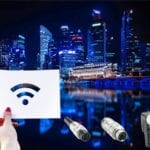Connectors in the LED Lighting Era
Components for LED lighting connections and controls have evolved alongside current bulb options.
Lukas Muth, Product Marketing PCBs and Connection Technology, Phoenix Contact GmbH & Co. KG, Blomberg, Germany

The emergence of LED technology spurred a rapid transformation in the lighting industry. At first, preexisting solutions from the fields of device connection and control technology were used in the production and operation of LED lighting. Now, clearly defined interfaces between the light and the light source are a thing of the past. Today’s LED lighting is impressive with its variety of external shapes, versatility, and high proportion of electronic components.
Routing Cables Through the Lamp Housing
In principle, LED lighting consist of two parts: a light source (often called a light engine) and a controller. To support these components, cables with control signals and power supplies must be routed through the bulb housing. In the past, this routing was enabled by cable glands, which allowed engineers to route cables through a screw connection and then firmly connect them to the housing through a thread effect. Engineers then had to make additional connections inside of the light. This process has its own merit and is rarely questioned. However, newly developed alternative procedures can save a great deal of time.
Installation systems for various industrial devices and control technologies have been in use for many years. These systems manage power distribution in widely interconnected machines, systems, and buildings. Some of these product ranges also include panel feedthroughs that are perfectly suited to increasingly complex LED technology. Using these types of installation systems, engineers simply strip the cable, assign the wires, cut them flush with one another, and screw the cables together, which allows them to achieve secure connections with reduced installation times and flexible constructions. The components that comprise these systems also fulfill the requirements for protection classes IP68 and IP69K and boast an impact strength of IK07.

Housing feedthroughs and H- and T-distributors are well suited for rapidly cabling individual lights.
M12 Universal Connectors
M12 connectors offer another connection option for transmitting both signals and electric power to the control device. M12 connectors are robust and user-friendly, feature coding to prevent incorrect connections, and are available in a huge selection of preassembled configurations designed to enable quick, easy installations. These connectors are commonly used in automation technology for wiring sensors, light barriers, and drive components and have recently become even more popular due to further fieldbus developments and Industrial Ethernet applications.
Owing to this, lighting manufacturers can choose from a vast range of assembled M12 cables, connectors, and flush-type plug connectors, the latter of which is waterproof and especially ideal for protecting lighting electronics in outdoor application from water and dust. Some M12 plug connectors can also directly attach to PCBs via soldered surface-mount or through-hole connections. As a result, universal M12 connectors can secure a PCB directly to an LED module. Additionally, new types of screw connections can compensate for process-related production tolerances between connector housings and PCBs.

Universally applicable M12 systems compensate for the production tolerances between connector housings and PCBs.
Connection in the Housing
The controller and the LED module typically connect inside the light using pre-connected cables or device and control technology solutions designed for this type of wiring. In addition to the PCB connectors used for this purpose, there are also so-called “flying connections.” These plug systems consist of one socket and one plug component, each with a convenient push-in spring-cage connector, and allow users to establish connections by simply pushing the cables against the spring cage into the terminal point. Although it depends on the type of cable and plug system, no tools are usually required for this process; merely stripping the cable is generally sufficient.These systems also enable easy cable release, typically by either pushing a button in the plug system or by inserting a standard tool, such as a screwdriver, to remove the tension on the spring.
This technique, known as fine stripping, is a simple process done before assembly with a multi-pin connector. The counterpart of these plug systems is installed on the free cables of the LED module and, after assembly, the controller is simply plugged into the LED module.

Connectors create a flying connection between the LED module and the control device in the LED light.
Controlling the LED Module
Today’s smart controls utilize daylight sensors and presence detectors to deliver the right amount of light at the right time. Automation controllers can manage these tasks and are easily configured with user-friendly automation software. Digital inputs and outputs, Ethernet interfaces, and various types of communication protocols also help ensure that light is produced at the correct position and with the right intensity.
Summary
Many different components from device connection and control technologies can simplify installation processes and improve flexibility and efficacy when wiring and controlling LED lighting systems.
To learn more about connectors for LED applications, visit Phoenix Contact online.
Interested in a specific market? Click a market below for current articles and news.
Automotive, Consumer, Industrial, Medical, Mil/Aero, Datacom/Telecom, and Transportation












